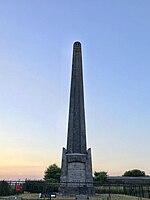Fort Nelson, Hampshire
Forts in HampshireForts in PortsmouthGrade I listed buildings in HampshireMilitary and war museums in EnglandMuseums in Portsmouth ... and 3 more
Museums sponsored by the Department for Culture, Media and SportPalmerston FortsUse British English from August 2015

Fort Nelson, in the civil parish of Boarhunt in the English county of Hampshire, is one of five defensive forts built on the summit of Portsdown Hill in the 1860s, overlooking the important naval base of Portsmouth. It is now part of the Royal Armouries, housing their collection of artillery, and a Grade I Listed Building.
Excerpt from the Wikipedia article Fort Nelson, Hampshire (License: CC BY-SA 3.0, Authors, Images).Fort Nelson, Hampshire
Winchester
Geographical coordinates (GPS) Address Nearby Places Show on map
Geographical coordinates (GPS)
| Latitude | Longitude |
|---|---|
| N 50.861 ° | E -1.1389 ° |
Address
Winchester
England, United Kingdom
Open on Google Maps



